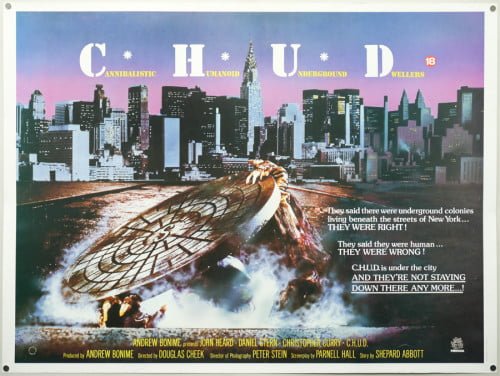Good old radioactive waste. Where would science fiction horror be without it? If you really stop to think about it: are there many radioactive-themed movies, games, or books that depict a happy story line for the people subjected to its devastating presence? Radioactivity in fictional media is often synonymous with fanatical, inbred, mutant freaks that are hell bent on stalking all the pretty people for whatever nefarious deeds they choose. In other words: If you’re cute, you’re probably going to die in the story.
A low-level “outbreak” of radioactive contamination doesn’t get much consideration, but high-level radioactive waste gets a ton of negative exposure. Take ‘C.H.U.D.,’ for instance. Anyone who has seen this movie knows there are two definitions for the title acronym, but I won’t spoil it for you if you haven’t seen it. Partially because the second definition is actually kind of dumb. Even for an ’80s movie. It’s true – money can make people pretty stupid.
In a poor, urban New York neighborhood, people are disappearing. At first, they are homeless men and women who take shelter living beneath the streets in old forgotten tunnels and sewers; not many citizens care about it. Later, when more important individuals begin being attacked and vanish as well, reporters and the police force begin to care. Something dangerous lives underground, birthed from the bowels of a contaminated sewer. Sewers are bad places? Go figure. Officials believe it’s not a big deal until reports of strange things start being taken more seriously. By then, it’s too late to stop the death of innocents to protect a secret government cover up.
Yes, it’s ‘C.H.U.D.’ – a look into how the fear of the unknown, particularly nuclear power and potential radiation effects, affected Hollywood in the 1980s.
As far as monster movies, it’s not a terrible one, but it does suffer a lot of downfalls that could have made it better. When compared to other ’80s films, it’s a sticky weird mixed bag of old Halloween candy. To me, it rates better than ‘Creature’ (1985), but not in the same league as ‘Leviathan'(1989) (fun fact: both ‘Leviathan’ and ‘C.H.U.D.’ feature ‘Home Alone’ villain Daniel Stern), even though the creatures used in all these films begin in a humanoid form.
Does “radiation exposure” have an unnecessarily bad reputation in pop culture? Well, maybe a highly exaggerated one, but no one can deny that it is dangerous in real life and bad things do happen when you mix it with a populated environment. Do birth defects happen? Yes. Radiation does some very bad things to animals and people. Do the affected people turn into green clawed savages and become opportunistic cannibals? Not…that I know of.
And what about the story of the film, you ask? Well, a photographer, a reporter, and several policemen go into the sewers… It sounds like a corny joke, but I’m not kidding, they do, and what they find down there is more than they can handle. The story itself isn’t a bad one and had decent potential, but something wasn’t catchy enough in the telling of it. As films go, there isn’t much memorable about it, beyond a few recognizable faces (yep, that’s John Goodman walking into that diner). Maybe if I’d seen it in the ‘80s when it first came out I might think differently, who knows?
On the whole, this is a very average movie with nothing remarkable about the story or the effects overall. Whether it’s because I’ve seen better- even from the time frame it came from, or just because it felt subpar, I can’t exactly say. It was “just okay” to me. That’s all I can really say about it. If you like creature movies, you might not mind watching this at 3 am, but I don’t think it’s a movie that most will actively seek out to watch. Though I find it is amusing that even now, some current pop-culture references herald back to it. One such mention is in an episode called “Last Call” from the TV show ‘Castle,’ where Nathan Fillion’s character offers up a line about “C.H.U.D people.” That in itself is a pretty neat nod to an old motion picture.
In reality, highly hazardous toxic material has to be stored for thousands of years for the danger to pass. It is human-engineered to be easier to store for that long, through several successful scientific processes. In fiction, since the correct method of containment doesn’t actually include dumping green glowing sludge in a barrel (I hope) and letting it rot underground somewhere (a popular depiction), it does make for some crazy stories that can come out of the ether.
Can I get a ” yay wind or solar-power energy” battle cry? There are a lot of people who live in the shadow of a nuclear reactor around the world. Who doesn’t fear the possibility, even however remotely possible, it might go critical some day? Now, that’s scary. At least if a wind farm goes critical, you’re looking at like a twenty-foot rotor blade buried in your front porch instead.
Not that that’s necessarily a good thing either, I suppose.

